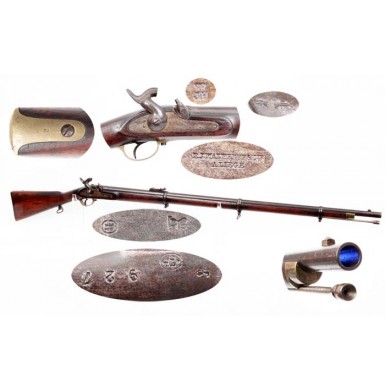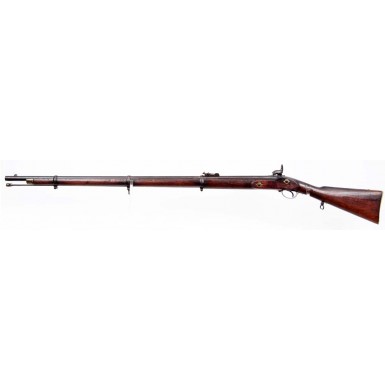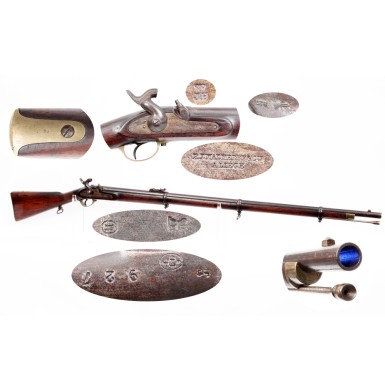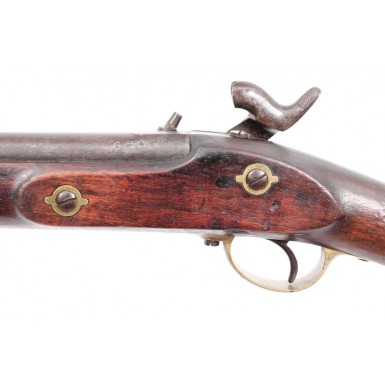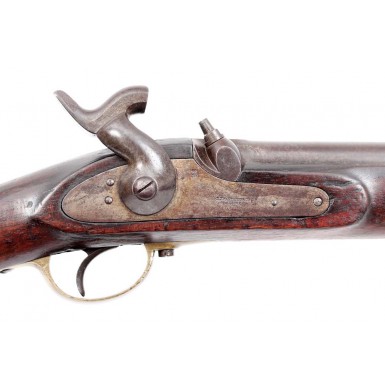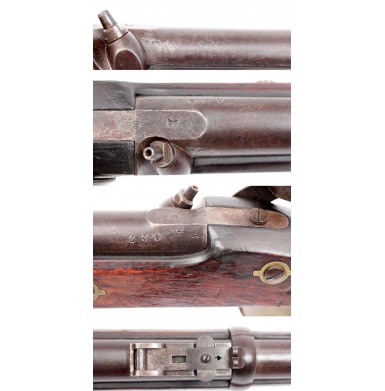Belgian Made Spanish M-1857 Rifle Musket - Rare
- Product Code: FLA-2798-SOLD
- Availability: Out Of Stock
-
$1.00
This is a wonderful, untouched and fresh from the attic example of a percussion long arm that is rarely encountered for sale in the United States. It is a Spanish Modelo 1857 Rifle Musket. In the 1850’s the Spanish adopted a series of percussion long arms that were nearly exact copies of the English Pattern 1853 Enfield family of arms. While all Spanish percussion military arms are scarce, a number of the M-1857 rifles (two band length) exist today “ most of which have a very strong association with Confederate importation and purchase. The longer, “3-band” rifle muskets are extremely scarce. While most examples of this gun that are encountered were produced in England by members of the Birmingham Small Arms Trade (BSAT), this example was produced in Li’ge, Belgium. The manufacturer is P.J. Malherbe & Cie, one of the largest and most successful of the 19th century Belgian arms makers, with the company operating at least three different factories simultaneously during the early and mid 1800’s. Malherbe appears to have concentrated on producing military contract arms, and examples of his arms are known in a wide range of patterns. Malherbe’s contacts ranged from the production of the Russian M-1843 L’ttich Carbine (aka “Russian Brunswick”) for the Czar, to producing the M-1851 and M-1857 Dresden Rifles for the Kingdom of Saxony. The company also produced the usual array of Belgian copies of French, English and other Germanic state arms for sale to whoever wanted them. While I had always assumed that at least some of the Spanish contract arms might have been produced in Belgium, this is the first example that I have been able to examine in detail. As with the Birmingham produced examples that I have handled, this rifle musket has a 39 ““ barrel. However the barrel does not have the oversized, 2 ““ octagonal breech section that is typical of Spanish rifles & rifle muskets of the period, and the British made examples. The breech section of this rifle musket follows the pattern of a standard P-1853 Enfield breech quite closely. Additionally, the barrel is rifled with four grooves, instead of the typical English pattern of 3 grooves. The bore measures .573, suggesting that like both the English and Spanish made examples, the gun is 26 bore, or nominally .57 caliber. The top of the breech is marked with an R within a circle at the breech plug to breech joint, and with a (CROWN) / AR on the breech. The left angled breech flat bears the usual Liege proof of the era, an E / LG / *, within an oval. The left flat is also marked with a small (CROWN) / JH and with the serial number 927. Serial numbers of this sort are often found both Spanish military arms and military pattern long guns produced by Malherbe. The right side of the breech, forward of the bolster, is marked with a small (CROWN) / N Belgian controllers proof, as well as with a Perron (a pineapple on a pillar), the mark of Li’ge. Interestingly, the usual Circle-Z Spanish proof mark found on Spanish made and most English contract Spanish arms is missing. This suggests that this particular rifle musket might never have reached Spain. Like the Spanish M-1857 Rifle, the rifle musket has the distinguishing characteristics of a spanner nut to retain the barrel band screws, a distinctively shaped lock and hammer based on the P-1853 Enfield, the lower sling swivel mounted to the rear of the triggerguard tang (instead of on the triggerguard bow), and the upper swivel mounted on the middle band instead of the upper band. The rifle musket also has a distinctive rear sight that is very similar in appearance to the sight found on the M-1857 Spanish rifle, with the exception that the rifle muskets sight is soldered directly to the barrel and not secured by a band around the barrel. The lock of the musket is marked in two lines, forward of the hammer: P.J. MALHERBE / A LI’GE. The same (CROWN / JH mark that is found on the breech is also found on the upper portion of the lock, forward of the hammer and just below and to the rear of the bolster. I have encountered this same inspection mark in both the metal and the wood of American Civil War era arms of different patterns and makers, produced in Belgium. It is my theory that this may be the mark of American arms dealer John Hoey. Hoey was a New York based arms speculator and dealer, with an office in New York City, and is also assumed that he had offices in Li’ge and possibly somewhere in Prussia. Hoey’s business was apparently short lived, as he was never listed in the official New York City directories. However, in the 20-month period between the start of the war and November of 1862, Hoey imported some 41,698 long arms for sale to the US Ordnance Department, along with 1,800 cavalry sabers. The arms were of 12 different patterns and varied in quality, quantity and cost from “11,480 Prussian Smooth Bore Muskets @ $6.00” (delivered on November 3, 1862) to “200 Short Enfield Rifles @ $26.00ea” (delivered November 9, 1861). While many of Hoey’s deliveries were of second, third and fourth rate arms (such as “1600 Continental Muskets @ $6.00ea”, some first class arms like the 200 “Short Enfields’ and “1,140 Enfield Rifle @ $21.00 to $26.50ea” (delivered on September 25, 1861) were also supplied. The fact that Hoey did not list the 1,140 “Enfield Rifles’ as “short” suggests that they were “3-band” rifle muskets, and not the shorter “2-band” rifles. The price variance also suggests that they varied in quality. I think it is quite possible that some of these “Enfield Rifles’ were in fact Belgian made Enfield copies, and quite possibly those manufactured for use by the Spanish. As the gun bears only a handful of minor differences from a typical P-1853 Enfield, the average arms inspector would probably not notice that these were not actually real “Enfields”, or even British made. In an Ordnance Department that could rarely tell the difference between French and Belgian arms, and which often listed Malherbe manufactured “Saxon Rifles’ as Belgian guns because of what they looked like, rather than the pattern of arm they really were, it is quite plausible to believe that at least some Continental “Enfields’ were handed out to US soldiers who thought they were getting British Enfields.
The gun is in overall FINE condition, and has a wonderful, untouched patina. The gun has an attractive oxidized plum-brown color, mixed with some traces of the original blued finish. This appearance is consistent over the entire gun. The metal of the gun is almost entirely smooth, with only some lightly scattered peppering and pinpricking present, with some more moderate pinpricking present in the breech and bolster area. This is typical of percussion arms that saw any use and service. The lock plate has a mostly smooth, mottled, gray-brown patina. The brass triggerguard has a lovely, medium golden patina, with the buttplate having been polished at some point in time and being somewhat brighter. The buttplate is marked with Malherbe’s (CROWN) / M mark. The lock functions crisply and correctly on all positions and remains mechanically excellent. The musket retains its original rear sight, and its original Spanish pattern percussion cone (nipple), which has rectangular, rather than square, shoulders. The original front sight/bayonet lug is present as well. Both of the original sling swivels are in place, one at the rear of the brass triggerguard tang, and one on the middle barrel band. The ramrod in the channel under the barrel is an original, Spanish pattern rod with a straight shank and brass tipped tulip head. The rod is very similar to the Austrian M-1854 Lorenz ramrod of the period and has a torque hole through the head, just like the Austrian rods do. The rod is the correct full length at 39 “, retains the original threads at the end. The bore rates about VERY GOOD+ condition overall, with strong rifling present its entire length. The bore is dark and well seasoned, but may clean up somewhat with a vigorous scrubbing. The bore shows light pitting scattered along its entire length. The stock is in about FINE condition as well, and shows only the usual assortment of bumps, dings, impact and wear marks that are associated with a 150 year old military musket. The stock retains very crisp lines and edges throughout, and shows no indications of having been sanded. The wood to metal fit is very fine throughout, and excellent workmanship is clearly evident. The stock is full length and solid and free of any breaks or repairs. At the tail of the stock flat, opposite the lock, is the remnants of an oval, US style, inspection cartouche. However, the cartouche is not legible.
Overall this is an extremely attractive, complete and untouched example of a percussion rifle musket that is rarely encountered for sale in America. It is difficult to know for sure how this musket arrived here, and whether or not it has a direct Civil War link, like the M-1857 Spanish Short Rifles do. However, this Belgian made gun is a very close copy of an Enfield, but is void of the usual Spanish acceptance proof. This suggests that the gun never reached Spain. The presence of the (CROWN / JH) mark, that I feel is that of arms dealer James Hoey of New York, further suggests that this gun may have come to America as part of a Civil War arms shipment. The presence of what looks to be a US inspection cartouche on the stock flat lends more support to that theory. One way or the other, it is a very scarce Spanish military pattern rifle musket, made by one of the best-regarded Belgian makers, and in wonderful condition. This is one of those wonderful guns that you simply don’t have to worry about all of your collecting buddies saying, “I’ve got one of those too” when you show it to them. You will be quite pleased to add this fine musket to your collection of 19th century military arms.
SOLD
